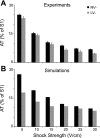Polarity reversal lowers activation time during diastolic field stimulation of the rabbit ventricles: insights into mechanisms
- PMID: 18708441
- PMCID: PMC2593523
- DOI: 10.1152/ajpheart.00706.2008
Polarity reversal lowers activation time during diastolic field stimulation of the rabbit ventricles: insights into mechanisms
Abstract
To fully characterize the mechanisms of defibrillation, it is necessary to understand the response, within the three-dimensional (3D) volume of the ventricles, to shocks given in diastole. Studies that have examined diastolic responses conducted measurements on the epicardium or on a transmural surface of the left ventricular (LV) wall only. The goal of this study was to use optical imaging experiments and 3D bidomain simulations, including a model of optical mapping, to ascertain the shock-induced virtual electrode and activation patterns throughout the rabbit ventricles following diastolic shocks. We tested the hypothesis that the locations of shock-induced regions of hyperpolarization govern the different diastolic activation patterns for shocks of reversed polarity. In model and experiment, uniform-field monophasic shocks of reversed polarities (cathode over the right ventricle is RV-, reverse polarity is LV-) were applied to the ventricles in diastole. Experiments and simulations revealed that RV- shocks resulted in longer activation times compared with LV- shocks of the same strength. 3D simulations demonstrated that RV- shocks induced a greater volume of hyperpolarization at shock end compared with LV- shocks; most of these hyperpolarized regions were located in the LV. The results of this study indicate that ventricular geometry plays an important role in both the location and size of the shock-induced virtual anodes that determine activation delay during the shock and subsequently affect shock-induced propagation. If regions of hyperpolarization that develop during the shock are sufficiently large, activation delay may persist until shock end.
Figures






References
-
- Anderson C, Trayanova N, Skouibine K. Termination of spiral waves with biphasic shocks: role of virtual electrode polarization. J Cardiovasc Electrophysiol 11: 1386–1396, 2000. - PubMed
-
- Anderson C, Trayanova NA. Success and failure of biphasic shocks: results of bidomain simulations. Math Biosci 174: 91–109, 2001. - PubMed
Publication types
MeSH terms
Substances
Grants and funding
LinkOut - more resources
Full Text Sources
Other Literature Sources

